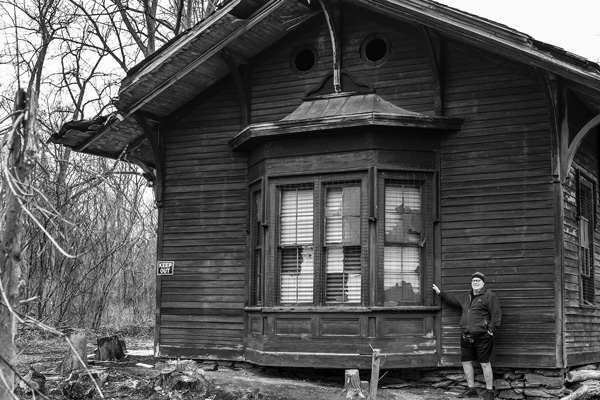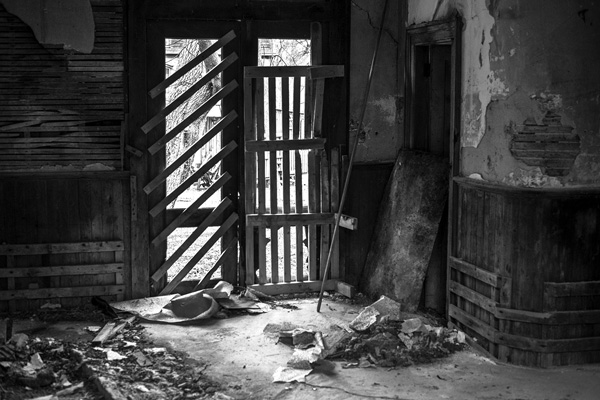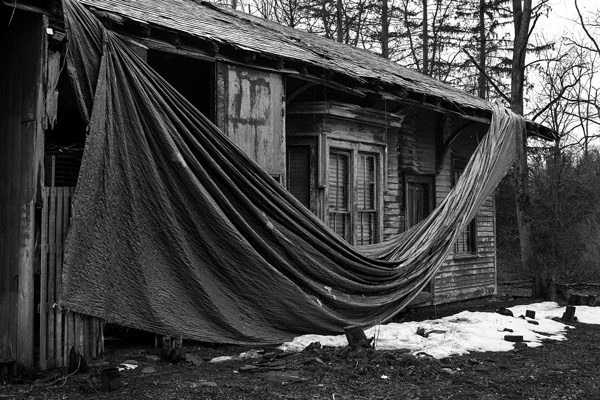News & Issues April 2023
Group works to save New Lebanon depot
Long-defunct station could serve as attraction along developing rail trail

Joe Ogilvie, president of the Corkscrew Rail Trail Association, stands outside the bay window of the former Rutland Railroad station in New Lebanon, N.Y., where the last train rolled past 70 years ago.Joan K. Lentini photo
By JOHN TOWNES
Contributing writer
NEW LEBANON, N.Y.
A local group is racing time to save and restore a historic but derelict former train depot in the center of New Lebanon.
The effort is being led by the Corkscrew Rail Trail Association, a nonprofit group formed in 2014 to create a recreational walking and cycling trail along the former route of a long-defunct Rutland Railroad line through Stephentown and New Lebanon.
The association opened the first segment of the rail trail in 2015: a 2.5-mile section from Knapps Road to Wyomanock Road in Stephentown. The group also maintains a separate trail section in New Lebanon and hopes to link the two segments in the years ahead.
The push to save the New Lebanon depot began when the association acquired the building last spring.
In 2018, the association bought 3.4 acres along the former railroad route about a block north of Route 20, from Tilden Road to Lovers Lane, behind the Tilden Plaza shopping center and the New Lebanon Library. It opened a new quarter-mile trail section there in 2019.
In May 2022, the New Lebanon parcel was enlarged to 4.5 acres when the previous owner of the depot donated the building and land around it to the association.
The association’s goal is to create a small park there and restore the depot building as a multi-use center for local history and as a site for community meetings and other activities.
“Today most people don’t even know the depot exists,” said Joe Ogilvie, president of the Corkscrew Rail Trail Association. “It needs a lot of work. But it’s a beautiful building with a lot of history. It has the potential to become an important asset to the community.’
The wooden depot, built in 1863, has a footprint of about 1,200 square feet and is nearly 18 feet tall.
It was one of numerous depots that once stood along the train line, which extended from Chatham through New Lebanon, Stephentown and Berlin to Bennington, Vt. Many of those structures have disappeared in the 70 years since the line was abandoned.
In its heyday in the late 19th and early 20th centuries, the New Lebanon depot served passengers from New York City and elsewhere who visited the nearby Lebanon Springs Spa, a popular resort destination of the era.
It also served as freight depot for dairy products, produce, coal and other goods. It was the primary shipping point for the nearby factory of Tilden & Co., a prominent producer of medicinal extracts.
Passenger service was discontinued in 1931, but the line and depot continued to be used for freight until 1953, when it was shut down and the tracks were removed.

Supporters of the effort to save the old station say the debris-filled interior could one day be restored to its original appearance. But the first priorities are to pay the back taxes and stabilize the structure. Joan K. Lentini photo
Back taxes, stabilization, restoration
As part of its deal to acquire the New Lebanon depot, the rail trail association agreed to pay the property’s accumulated back taxes to Columbia County. The county waived the interest and penalties.
The association raised and has paid $14,000 of the tax bill. It is currently working to raise $6,000 to pay the remaining balance.
“That’s our first priority, and it has to be done quickly within the coming months to enable us to keep it,” Ogilvie said.
Once that has been accomplished, the association will turn its focus to physical restoration of the depot.
The building’s slate roof and foundation have deteriorated, and the overall structure has suffered extensive damage over time.
Ogilvie said the group aims to rehabilitate the building in stages, with the first phase covering basic repairs to prevent further damage. Later stages will have the goal of restoring the building back to its original appearance.
“We will have to do it in phases,” Ogilvie said. “The first priority is to repair and stabilize the roof, which has a hole in it and is partially collapsed. We will also have to repair the foundation.”
He said estimates for the roof work range from $50,000 to $60,000, while the foundation repair will likely cost between $20,000 and $30,000.
“Those are rough estimates,” Ogilvie said. “We have to find a contractor who will be able to evaluate exactly what is needed.”
He said a complete restoration is expected to take about four to five years.
“However the exact timetable for all of this will depend on how successful we are in raising funds,” he added.
(The group has set up a page on the GoFundMe website for donations at https://gofund.me/c554fe3a.)
In the meantime, he said, volunteers have been doing other tasks to clean up the site and prepare the building for renovation.
“We will be doing a lot of work in the coming months,” he said. “Our hope is that we can clean up the depot and make it accessible so people can see what’s there and visualize what it can look like when its restored.”

Piecing together an old route
The current goal of the Corkscrew Rail Trail Association is to create a publicly accessible trail along the section of the old Rutland Railroad line through Stephentown and New Lebanon. The route runs south parallel to Route 22 and then turns to the west in New Lebanon, paralleling Route 20.
This railroad line was originally assembled in the 19th century and became part of a larger regional system acquired by the Vermont-based Rutland Railroad in 1901.
The route, dubbed the “corkscrew line” because of its many twists and turns, began in Bennington, Vt., and headed west and south into New York through Petersburgh, Berlin, Cherry Plain, Stephentown and New Lebanon. From there it turned to the west through the hamlet of Brainard and then southward to Chatham. At Chatham, it tied into a major east-west line from Boston to Albany as well as a route south to New York City.
In Bennington, the line fed into the Rutland Railroad’s main route north to Manchester, Rutland, Burlington and Alburgh, where it made connections into Canada and northern New York.
Today, the former corkscrew line’s right-of-way is primarily in the hands of private landowners. It passes through a mix of open fields and woods as well as areas of commercial and residential development.
People have long used sections of the rail bed informally as a walking trail. The association is working to acquire easements along the route to connect the sections and create a more formalized, continuous, publicly accessible trail.
The Corkscrew Rail Trail Association is a grassroots effort supported by donations. It also relies on the willingness of landowners along the route to allow public access to the sections of the old rail line that run through their properties. Where it is open to the public, the trail is a modest unpaved pathway.
“It’s a long-term project, and we realize it will take years to complete,” Ogilvie said. “It involves obtaining the permission of many landowners, as well as the physical work of preparing a trail.”
He noted that in areas where the group cannot acquire permission to use the actual track bed, they likely will look for nearby alternatives on other land that would create a continuous route.
The Corkscrew Rail Trail reflects a larger effort by many organizations, governments and individuals to eventually establish a wider regional network of recreational trails by connecting other walking and bike paths.
For example, to the south, the Harlem Valley Rail Trail extends for about 25 miles along a former railroad route from Wassaic to Hillsdale. In the future, trail advocates hope to extend it northwest to Chatham, where is could connect to the southern end of the old corkscrew line.
Ogilvie said that although the Corkscrew Rail Trail Association is primarily focused on the trail sections in Stephentown and New Lebanon, the organization also envisions extending the trail to the west, south and north.
“We’re interested in talking with any landowners in other communities along the line who are interested in adding to the trail,” he said.
For more information about the effort, visit the website www.corkscrewrailtrail.org or the Facebook page Corkscrew Rail Trail.
